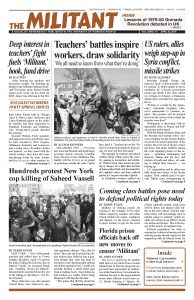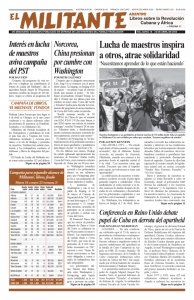The Young Karl Marx, 2017 film, directed by Raoul Peck.
The development of the first revolutionary international workers association, the Communist League, and The Communist Manifesto, the program it adopted in 1847, are a rich treasure for study by workers today. Unfortunately, and contrary to what a review in the Nov. 27 Militant said, the movie “The Young Karl Marx” doesn’t tell the true story of what happened.
For anyone watching the film, and anyone interested in advancing the organization and self-confidence of the working class, I strongly recommend reading “On the History of the Communist League,” an 1885 article by Frederick Engels.
The film covers the period from 1843 to the beginning of 1848. We see the start of what became the lifelong political collaboration of Marx and Engels, both then young revolutionaries in their 20s. It gives a glimpse of the conditions and struggles of the working class in the English textile mills; of the artisans who were part of the proletariat-in-becoming throughout western Europe; of the battle of the peasants in Germany. It depicts what seem to be debates Marx and Engels had with opponents, such as the Young Hegelians and Pierre Proudhon, as they worked to clarify their revolutionary outlook. But the film doesn’t reflect the real politics they’re developing and debating.
And on the crucial question of the formation of the Communist League, the film is a total distortion. A key scene shows Marx and Engels meeting for the first time with three seemingly distrustful leaders of the League of the Just in February 1846, with the aim of pushing them aside and taking over the organization. These leaders of the League, who aren’t identified, are portrayed as narrow-minded, clueless workers, and Marx and Engels as scheming connivers.
‘First revolutionary proletarians’
In “On the History of the Communist League,” Engels describes how the League of the Just evolved from its founding in 1836 as a secret society of German political refugees, first in Paris and later in London and elsewhere, into a revolutionary working-class party. Far from being bumbling fools, its leaders were workers and artisans such as Karl Schapper, Heinrich Bauer and Joseph Moll — all of whom had spent years organizing to fight capitalism and its effects on the lives of their class. They had faced jail and deportation, been wounded in battle, and had dealt with police and provocateurs.
“I came to know all three of them in London in 1843,” Engels wrote. “They were the first revolutionary proletarians whom I met, and however far apart our views were at that time in details — for I still owned, as against their narrow-minded egalitarian communism, a goodly dose of just as narrow-minded philosophical arrogance — I shall never forget the deep impression that these three real men made upon me, who was then still only wanting to become a man.”
Marx got to know leaders of the League of the Just in Paris around the same time. He and Engels “published a series of pamphlets” criticizing the hodgepodge of radical political nostrums “which formed the secret doctrine of the ‘League’ at that time,” Marx wrote in 1860. “In its place we proposed the scientific study of the economic structure of bourgeois society as the only tenable theoretical foundation. Furthermore, we argued in popular form that it was not a matter of putting some utopian system into effect, but of conscious participation in the historical process revolutionizing society before our very eyes.”
Marx and Engels also joined other emigres to found a German Workers Educational Association in Brussels. They maintained contact with the revolutionary-minded section of the English Chartist labor movement, with the French Social Democrats, the League and others looking to advance the interests of the working class.
Through their own experiences, the worker-leaders of the League in London became increasingly convinced that the positions of Marx and Engels were correct, that they needed to break free of the old conspiratorial organizational forms. “In the spring of 1847 Moll … invited us repeatedly, in the name of his comrades, to join the League,” Engels wrote. “Should we join, we would be given an opportunity of expounding our critical Communism before a congress of the League in a manifesto, which would then be published as the manifesto of the League.”
They accepted. The political and organizational questions involved were debated at length over two congresses, in the summer and winter of 1847. The group renamed itself the Communist League, and set out to build a public propaganda organization.
The film ignores how Marx and Engels were won to these workers and their organization at the same time as its leaders were won to their revolutionary program and outlook. And the working class is depicted as objects — a suffering class — not as actors capable of transforming human history.
The movie refers to Engels’ 1845 book The Condition of the Working Class in England. But it doesn’t even hint that the book includes a substantial description of the development and activity of the English trade unions and the Chartists that evolved into an independent working-class political movement. The young Engels and Marx were attracted above all to the proletariat as a fighting class.
The film ends with brief notes stating that revolutionary struggles broke out across Europe in 1848, “the international workers’ movements arose from these ruins,” The Communist Manifesto remains in print, and “Marx would keep writing his key work, Capital, until his death.”
Viewers wouldn’t have a clue that Marx, Engels and many other cadres of the Communist League remained active, lifelong party builders, seeking ways to organize the working class into effective labor and political action. When downturns in the class struggle led to dissolution of the Communist League in 1852 — following the defeat of the revolutionary wave in 1848 — they would grab the opportunity in new upsurges to rebuild. They founded the International Workingmen’s Association in 1864 as the class struggle deepened again.
If you want to know who Marx and Engels were, the program they fought for, how they immersed themselves in the working-class movement, and how their ideas and activities are relevant for our struggles today, get in touch with the Socialist Workers Party and join us to read and discuss what they wrote — and to act to put it in practice.

